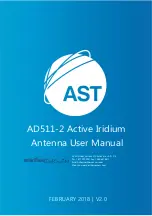
5
AD511-2 Active Iridium Antenna User Manual | Feb 2018 | 2.0
3.
Mounting and Operation
AD511-2 should be mounted with an unobstructed view of the sky. An aluminium bracket with
V-bolts is provided to attach the antenna to horizontal or vertical masts or spars up to 50mm in
diameter, figure 2. The bracket is shipped inverted at the centre of the AD511-2 antenna and
should be detached, inverted, then reattached to antenna case using the mounting holes in
the base.
The coaxial down-lead is attached to the N-type connector on the underside of the antenna,
figure 2. Wrapping the connectors with self-amalgamating tape is recommended for
permanent installations and the cable should be taped or strapped to the spar as appropriate.
AD511-2 antenna supplied with coaxial down-leads must be used with the accompanying
AD511-3 DC Power Break-In Box (figure 3), which a18V to +36V DC at 500mA. The
down-lead must not be shortened by the user.
AD511-3 Power Break-In should be positioned close to the telephone base- station or handset.
The coaxial down-lead is then attached to the N type connector on the AD511-3 (figure 3 &
figure 4).
Earthing: - the AD-511-3 power breaking box is provided with an earth terminal. The box should
be earthed via this connection with a short earthing lead connection to the system earth.
Connection between the telephone and the AD511-3 is made with a coaxial cable terminated
with TNC connectors. An adapter is provided with the Iridium handset, which enables a TNC
terminated cable to be attached to the telephone. AD511-3 case has drilled flanges to enable
permanent fixing.
A 1m flying lead for the AD511-3 Power Break-In Box is provided for connection to the DC supply
(+18 to 36 v DC at 500mA), which can be trimmed (or extended) if necessary. The red wire is
connected to supply positive, whilst the blue wire is for either an isolated or grounded negative
supply. AD511-3 is protected against output short-circuiting by a fuse, which is resettable by
disconnecting the unit from the +18 to +36 v DC supply.
With all connections made, the telephone can then be turned on and used as normal - it is
transmitting into a load impedance equivalent to a matched passive antenna. The gains of the
antenna transmitter and receiver are factory set to compensate for the total attenuation
between the telephone and the antenna, mainly determined by the coaxial down-lead.
Consequently, the signal output level and frequency from the antenna is equivalent to that
radiating from a passive antenna mounted directly on the handset, subject to the antenna
transmitter being a linear device. Transmitter linearity is verified with test protocols using an HP
8591 EMC analyser that also ensure there are no spurious out of band emissions.

























